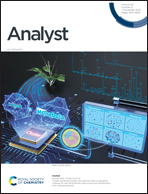Implementing reactive secondary electrospray ionization based on gas–droplet reactions for VOC analysis†
Abstract
Gas–droplet reactions occur at the microdroplet interface and tend to be greatly accelerated, which has great potential value in chemical analysis. To exploit such value, we combined online derivatization with secondary electrospray ionization (SESI) to implement a special ionization technique, termed reactive SESI, for rapid analysis of gas samples. Specifically, a suitable reagent was added to the spray solvent of SESI to initiate rapid derivatization of gas analytes in the microdroplets. The product ions are subsequently detected using a mass spectrometer. Compared to offline derivatization in bulk solution, reactive SESI can provide a higher yield and a faster reaction rate, and it allows the detection of intermediate ions. It is found that the signal changes of the analyte, intermediate, and product ions are highly consistent, indicating that a two-phase derivatization process may occur at the droplet interface. For reactive SESI-MS analysis, the use of a sub-ambient pressure SESI source can significantly improve the detection efficiency, making this technique truly useful for analytical applications, including the quantification of formaldehyde at tens of ppb levels in air, as well as the detection of various trace VOCs in exhaled breath from mice.



 Please wait while we load your content...
Please wait while we load your content...